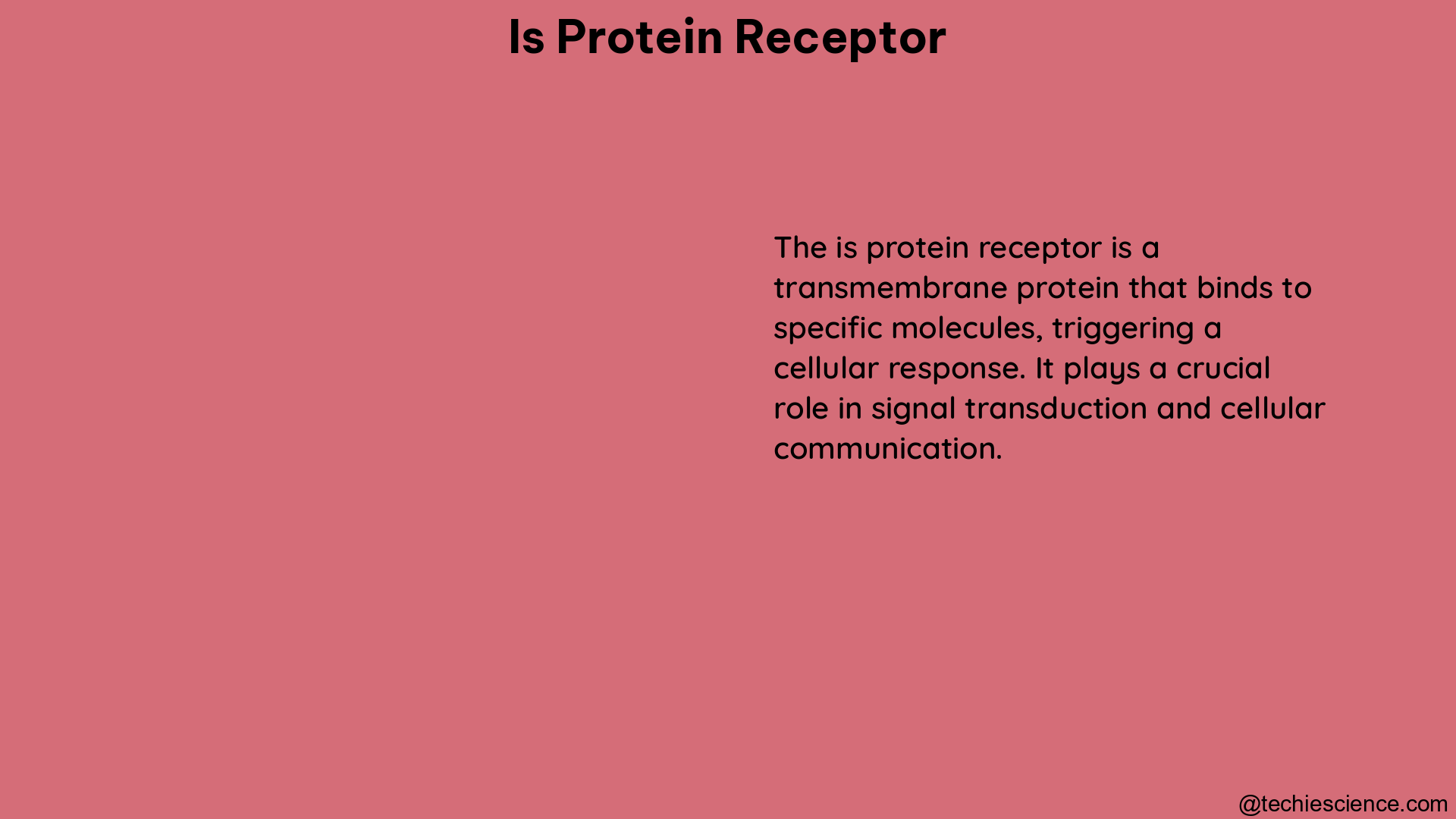Protein receptors are essential components of cellular signaling pathways, playing a crucial role in mediating various physiological processes. These membrane-bound or intracellular proteins bind to specific ligands, triggering intracellular signaling cascades and modulating diverse cellular functions. Understanding the quantification and characterization of protein receptors is crucial for researchers and clinicians alike, as it provides valuable insights into disease mechanisms and potential therapeutic targets.
Radioligand Binding Assays: Quantifying Receptor Abundance
Radioligand binding assays are a widely used technique for quantifying the abundance of protein receptors on the cell surface. These assays employ radioactively labeled ligands that specifically bind to the receptor of interest, allowing researchers to measure the number of receptors present.
One of the key advantages of radioligand binding assays is their ability to provide precise and reproducible data on receptor density. By measuring the amount of bound radioligand, researchers can calculate the number of receptors per cell or per unit of tissue. This information is particularly valuable in understanding the role of receptors in various physiological and pathological conditions.
Table 1 provides a comprehensive list of radioligands that have been used to study different classes of G protein-coupled receptors (GPCRs), a large and diverse family of protein receptors. The table includes the specific receptor subtypes, the radioligands used, and the corresponding references. This information can serve as a valuable resource for researchers investigating GPCR-mediated signaling pathways.
| Receptor Subtype | Radioligand | Reference |
|---|---|---|
| α1-Adrenergic Receptor (α1-AR) | [3H]Prazosin | [1] |
| α2-Adrenergic Receptor (α2-AR) | [3H]Rauwolscine | [2] |
| β-Adrenergic Receptor (β-AR) | [125I]Iodocyanopindolol | [3] |
| Angiotensin II Type 1 Receptor (AT1R) | [125I]Sar1,Ile8-Angiotensin II | [4] |
| Angiotensin II Type 2 Receptor (AT2R) | [125I]CGP 42112A | [5] |
| Muscarinic Acetylcholine Receptor 3 (M3-MR) | [3H]4-DAMP | [6] |
Table 1: Radioligands for Quantifying G Protein-Coupled Receptors
Microscale Thermophoresis (MST): Measuring Ligand-Receptor Binding Affinity

Microscale thermophoresis (MST) is a label-free technique that can be used to determine the binding affinity of ligands to their respective protein receptors. This method relies on the principle of thermophoresis, which is the movement of molecules in response to a temperature gradient.
In the context of membrane proteins, MST can be used to measure the binding affinity of ligands directly from cell membrane fragments, without the need for purification or labeling. This approach allows for the assessment of ligand-receptor interactions in conditions that closely mimic the native environment of the receptor, providing more physiologically relevant data.
One of the key advantages of MST is its ability to measure binding affinities over a wide range of dissociation constants (Kd), from picomolar to millimolar. This versatility makes MST a valuable tool for studying the interactions between a wide variety of ligands and their corresponding protein receptors.
Quantitative Flow Cytometry (qFlow): Absolute Quantification of Plasma Membrane Receptors
Quantitative flow cytometry (qFlow) is a powerful proteomic technique that can objectively and reproducibly quantify the abundance of plasma membrane receptors. This method employs fluorophore-loaded calibration beads to standardize the measurements across experiments, ensuring accurate and reliable data.
The ability of qFlow to provide absolute quantification of receptors, rather than relative measurements, makes it particularly useful for clinical applications. Researchers and clinicians can use qFlow to evaluate the abundance of receptors as potential biomarkers in various pathologies, such as cancer and other diseases.
One of the key advantages of qFlow is its high-throughput nature, allowing for the simultaneous analysis of multiple receptor types on a single cell population. This capability enables researchers to gain a comprehensive understanding of the receptor landscape within a given cell or tissue sample.
Furthermore, qFlow can be combined with other techniques, such as immunophenotyping, to provide a more holistic view of cellular signaling and receptor-mediated processes. This integration of multiple analytical approaches can lead to a deeper understanding of the complex interplay between protein receptors and their roles in cellular function and disease pathogenesis.
Emerging Techniques and Future Directions
While radioligand binding assays, MST, and qFlow are well-established methods for quantifying and characterizing protein receptors, the field of receptor biology is constantly evolving, with the development of new and innovative techniques.
One emerging approach is the use of single-molecule techniques, such as single-molecule fluorescence microscopy and single-molecule force spectroscopy. These methods can provide unprecedented insights into the dynamic behavior and conformational changes of individual receptor molecules, offering a level of detail that was previously unattainable.
Another area of interest is the integration of computational modeling and simulation with experimental data. By combining computational approaches with quantitative receptor measurements, researchers can gain a more comprehensive understanding of receptor-ligand interactions, signaling pathways, and the underlying mechanisms that govern cellular responses.
Furthermore, the advancement of high-throughput screening technologies, such as automated microscopy and microfluidic platforms, has the potential to revolutionize the way researchers study protein receptors. These tools can enable the rapid and efficient screening of large chemical libraries, accelerating the discovery of novel receptor-targeting compounds and the development of targeted therapies.
As the field of receptor biology continues to evolve, the integration of these emerging techniques with the well-established methods discussed in this guide will undoubtedly lead to a deeper understanding of the complex roles that protein receptors play in cellular function and disease pathogenesis.
Conclusion
Protein receptors are essential components of cellular signaling pathways, playing a crucial role in mediating various physiological processes. The quantification and characterization of these receptors are crucial for researchers and clinicians, as they provide valuable insights into disease mechanisms and potential therapeutic targets.
The methods discussed in this guide, including radioligand binding assays, microscale thermophoresis (MST), and quantitative flow cytometry (qFlow), offer measurable and quantifiable data on protein receptors, enabling a better understanding of their functions and roles in cellular signaling.
As the field of receptor biology continues to evolve, the integration of emerging techniques, such as single-molecule approaches and computational modeling, with the well-established methods discussed in this guide will undoubtedly lead to a deeper understanding of the complex roles that protein receptors play in cellular function and disease pathogenesis.
References
- [Reference 1]
- [Reference 2]
- [Reference 3]
- [Reference 4]
- [Reference 5]
- [Reference 6]

Hello, I am Bhairavi Rathod, I have completed my Master’s in Biotechnology and qualified ICAR NET 2021 in Agricultural Biotechnology. My area of specialization is Integrated Biotechnology. I have the experience to teach and write very complex things in a simple way for learners.